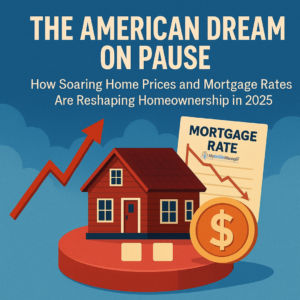For generations, homeownership has been the cornerstone of the American Dream. It symbolized security, stability, and financial progress. But in 2025, many families find themselves increasingly locked out of this once-attainable milestone. According to a recent report from KJZZ, the combination of rising home prices, climbing mortgage rates, and limited inventory has put homeownership out of reach for a growing number of Americans. The question now is not just when people will buy—but if they will buy at all.
The Affordability Crisis: A Perfect Storm
The heart of today’s housing dilemma lies in an affordability crisis fueled by multiple economic pressures:
-
Soaring Home Prices: Over the past few years, home prices have surged dramatically. Even moderate increases in home values have compounded as buyers compete for limited inventory, pushing prices higher than many middle-class families can afford.
-
Climbing Mortgage Rates: Mortgage interest rates, which hovered near historic lows during the pandemic, have steadily climbed since 2022. For many buyers, higher rates translate into hundreds—or even thousands—of dollars more in monthly payments. A home that might have seemed affordable at a 3% interest rate suddenly becomes cost-prohibitive at 6% or 7%.
-
Shrinking Supply: Inventory remains critically low across much of the country. Builders have struggled to keep pace with demand, and many existing homeowners are reluctant to sell, locking up supply even further. This lack of inventory continues to drive prices upward and intensifies competition among buyers.
-
Widening Financial Burden: Today, the average homeowner spends about 42% of their monthly income on housing costs—up from 28% just a few years ago. This imbalance forces many families to either dramatically adjust their financial priorities or delay homeownership altogether.
The Impact on Families: Delayed Milestones, Altered Plans
The effects of this affordability crunch ripple far beyond the real estate market:
-
Older First-Time Buyers: The median age of first-time homebuyers has climbed to 38, up from 35 just one year earlier. For many, student debt, stagnant wages, and rising living costs make it impossible to save for a down payment while juggling other financial obligations.
-
Postponed Life Events: Traditionally, homeownership often coincided with marriage, starting a family, and establishing long-term roots. Now, many younger adults are delaying these milestones, choosing financial security and flexibility over the burden of a large mortgage.
-
Shift Toward Renting: Increasingly, families are opting to rent longer, recognizing the advantages of flexibility, fewer financial risks, and the ability to live in desirable locations without committing to sky-high home prices.
A Shift in Mindset: Rethinking the American Dream
While many still aspire to own a home, expectations are evolving:
-
Renting as a Viable Alternative: Georgetown sociology professor Brian McCabe emphasizes that although homeownership remains a strong cultural value, more Americans are recognizing that renting offers benefits that fit modern lifestyles—mobility, financial stability, and access to neighborhoods they might not otherwise afford.
-
Flexibility Over Ownership: For younger generations, flexibility often takes priority over the traditional path to homeownership. The ability to relocate for work, travel, or family needs without being tied down by a mortgage is becoming increasingly attractive.
-
Financial Pragmatism: Rather than overextending themselves, many families prefer to keep savings liquid, invest in education, or focus on retirement, rather than sink everything into a costly home purchase.
The Search for Solutions: What Can Be Done?
While some local and federal programs aim to help first-time buyers, experts agree that the solutions must address multiple layers of the problem:
-
Boosting Inventory: Expanding housing supply is key. Encouraging new construction, particularly of affordable homes, could help ease price pressures.
-
Down Payment Assistance: Programs that assist buyers with down payments can help bridge the gap for younger or lower-income families struggling to enter the market.
-
Interest Rate Relief: Stabilizing or reducing interest rates through targeted policies could help make mortgages more affordable again.
-
Rethinking Zoning Laws: Updating outdated zoning regulations to allow for higher-density and mixed-use developments can increase housing availability, particularly in high-demand areas.
Conclusion: A Redefinition in Progress
The American Dream isn’t dead—but it is being redefined. In 2025, many families face the reality that homeownership may no longer be the default measure of success. Instead, financial flexibility, personal fulfillment, and long-term security—whether through renting or alternative investments—are emerging as equally valid aspirations.
As policymakers, builders, and communities search for ways to restore housing affordability, families continue to adapt, rewriting the narrative of what the American Dream means in the modern era.
Source:
-
With Home Prices, Mortgage Rates High, Many Families Find American Dream Out of Reach — KJZZ
Read the full article here.

